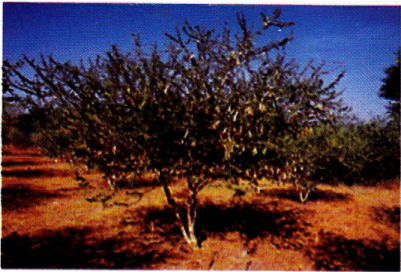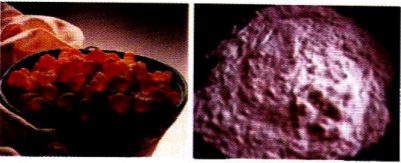Gum Arabic
Gum Arabic
Gum arabic is the natural gum exuded by various species of Acacia. The main source of commercial gum arabic is Acacia senegal L.willd.
Local names: Hindi & Rajasthani: Kumta,kumat
Plant Sources: Acacia senegal (L.) Willd. and Acacia seyal
Family: Leguminosae
Distribution : The trees are native of North Africa and grow mainly in the sub.Sahara or Sahel zone of Africa and also in Australia, India and South America. A. senegal is found in some parts of India mainly in the dry rocky hills of south east Punjab, in the northern Aravalli hills and other drier parts of Rajasthan and Gujarat.
A. senegal is a small sized thorny tree (4 to 5 meters height). Acacia trees are grown from seedlings which are planted when they reach the height of 15-20 cm. Gum production can begin when the trees are 5 years old,although gum may be tapped from the trees after 3 years.However, the quality and yield are consistent only after 5 years.
Production in India: 800 tons per annum (approx).
Major producing countries: The main producing and exporting countries in the 'gum arabic belt' include Cameroon, Chad, Mali, Nigeria and Sudan. Sudan dominates the world gum trade with a market share of about 60%.
Harvesting & Collection of Gum
Method of harvesting/tapping: The gum exudes from the cracks on the bark of the tree under difficult conditions such as heat,dryness, wounds, and diseases. The gum flows naturally from the bark of the trees in the form of a thick and rather frothy liquid,and speedily concretes in the sun into tears.
The gum flows naturally from the bark of the trees in the form of a thick and rather frothy liquid,and speedily concretes in the sun into tears.
To accelerate exudation and to improve and regulate gum production,Acacia trees are tapped by means of incisions (60 cm x 5 cm) made in their branches some weeks ahead of time. Usually mature trees, 4.5-6 m high and 5-25 years old, are tapped by making incisions in the branches and stripping away bark. The gum starts to collect in the wound within 3-8 weeks, but this depends on the weather conditions. Gum droplets are about 0.75-3 cm in diameter, and they gradually dry and harden on exposure to the atmosphere. These gum tears are manually collected.
Efforts are now being made to improve gum yield by treatment of tree wounds with chemical irritant and injection of hormones.
Period of harvesting/collection: Collection of gum arabic takes place at intervals during the dry season from November to May. During the rainy season no gum is formed since the trees are in full bloom.
Yield: A tree, on an average, may yield 250 grams of gum arabic per annum, although production may range from a few grams to as high as 10 kg. The highest yields are observed on individuals aged from 7 to 12 years. A young nee usually yield 400-7000g annually.
In general, the higher the average temperature, the higher is the yield of gum.Damaged trees give larger yield of gum. Gum yields are improved by natural factors that lessen the vitality of the trees such as hot weather, poor soil, lack of moisture, etc.
Processing and Value Addition
Just after harvest, the gum is delivered to cleaning sheds for the removal of impurities.sand, and pieces of bark. There after it is sorted to different grades based on colour and per cent of impurities. Sorted and cleaned gum arabic is usually traded as tears that are approximately 2.5 to 5 cm in size packed in 100 kg jute bags.
Gum arabic is further processed in the destination countries into forms needed for incorporation into the final products. These processes include 'kibbling' (making uniform pebble size pieces), granulating, powdering and spray drying. Kibbling entails passing whole or large lumps of gum through a hammer mill and then screening it to produce smaller granules of more uniform size. These pieces are more easily dissolved in water, and under more reproducible conditions, than the raw gum and so are preferred by the end user.
Powdered gum may be produced from kibbled gum but it may also be produced by a process known as spray drying. This furnishes a high.quality, free.flowing powder with even better solubility characteristics than kibbled gum. The gum is dissolved in water filtered contamination,is sprayed Gun into a stream of hot air to promote evaporation of the water. The powder is then screened to assure uniformity of particle size.
Transportation and Storage: The crude gum arabic is stored and exported either in burlap or jute sacks. The graded gum is packed in heavy duty bags of about 80 kg each. The US regulations require that only new, unused jute sacks are used. Semi-processed and processed kibbled variety, granules and powdered gum arabic is exported in drums, polyethylene lined multi-wall paper bags or polyethylene lined cardboard boxes. Gum arabic, when stored in cool (21 -24℃) and dry place, has an unlimited shelf life.
Quality control: The specifications that are widely used by the importers when importing raw gum arabic are as follows:
- Optical rotation: provides assurances that the gum has not come from other tree species
- Moisture content: not more than 12-14% is permitted
- Foreign matter content: no more than 3-5 % is permitted
- Color(specific parameters)
- Viscosity (specific parameters)
- Microbiological count: tests for Salmonella,Escherichia coli and Staphyloccus aureus should be negative.
An FAO (JECFA) specification exists for gum arabic intended for use as a food additive and in the United States, a Food Chemicals Codex specification exists. For pharmaceutical use, gum arabic appears in many pharmacopoeias, including the British Pharmacopoeia.
The JECFA specification has undergone a number of revisions over the years. The present one (published in 1990) specifies limits on such things as loss on drying, ash,acid,insoluble matter, arsenic,lead and heavy metals. A BIS specification (IS 6795:1972) is there for food grade gum Arabic in India.
Properties
- Gum arabic is a neutral or slightly acidic salt of a complex polysaccharide containing calcium, magnesium, and potassium cations.
- Gum arabic is nontoxic, odourless, and has a bland taste and it does not affect the odour, colour or taste of the system in which it is used
- The gum is some what yellowish in colour.
- It is insoluble in oils.and in most organic solvents, but usually dissolves completely in hot or cold water forming a clear,mucilaginous solution.
- Hydrolysis of gum Arabic yields L-arabinose, L-rhamnose, D-galactose and D-glucuronic acid.
- It is in the GRAS (General Recognized As Safe) list under the Federal Food, Drug and Cosmetic Act.
lndustrial Applications
A brief summary of the industries that use gum arabic is given in the following
Food lndustry:
- Confectioneries:used to prevent crystallization of sugar
- Dairy Products:Used as a stabilizer in frozen products
- Bakery prodrcts: Used for its viscosity and adhesive properties
- Beverages:Used as a foam stabilizer in beer, and as a clouding agent to give opacity
- Flavour emulsifier used as an emulsifier and protective collide.
- Diabetic and dietectic product: Used because of its low level of metabolism.
Pharmaceutical Industry:
- Emulsions: Used as a stabilizer
- Tablets: Used as a binder
- Tablet coatings:Used as a mucilage
- Cough drops and syrups: Used as an emollient and demulcent
Cosmetic Industry:
- Lotions and protective creams: Used to give smooth feel
- Facial masks: Used as an adhesive
- Face powders:Used as an adhesive
Other Industries:
Adhesives: Used as a mucilage, as simple adhesive and glue for miscellaneous paper,glass and metal products
Ink: Used as a protective collide and suspending agent.
Lithography: Used as a sensitizers for lithographic plates, elements in the light- sensitive composition, ingredients of the fountain solution used to moisten plates during pointing, and protectors during storage of plates.
Paper: As a coating for speciality papers and such as a coacervate in carbonless paper.
Paints: Used as a protective collide, as a flocculant and emulsifier in vinyl resin emulsions.
Textiles: used as sizing and finishing agents and in printing formulations for imparting designs and decorations to fabrics, also used to thicken the dye baths that are used in the printing and dyeing of fibers, fabrics and carpets.
অকোনবা শেমদোকখিবা : 3/1/2020
Dammar designates a group of resins obtained from ...
This topic provides information about Guar gum.
This topic provides information about Guggul or In...
This topic provides information about Asafoetida.
